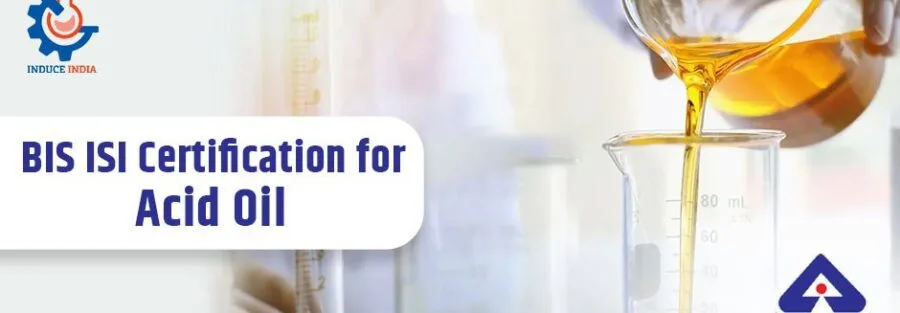Acid oil is a by-product obtained during the process of refining vegetable oils. It is a dark brown, viscous liquid that is typically high in free fatty acids, unsaponifiable matter, and impurities. Due to its high acidic content, acid oil is commonly used in the manufacturing of soap, detergents, and animal feed.
It can also be used as a raw material for the production of fatty acids, which are used in a wide range of industrial applications such as lubricants, coatings, and cosmetics.
Acid oil is generally considered to be a low-value by-product, but its use in various industries makes it an important commodity.
To ensure the quality of acid oil, the Bureau of Indian Standards (BIS) has developed a certification scheme under IS 12029:1986. This standard lays down the requirements and test methods for acid oil used in the manufacture of soap and detergents. The certification process involves testing the acid oil for its free fatty acid content, unsaponifiable matter, moisture content, and other impurities.
The certification mark indicates that the acid oil has met the specified quality requirements and is safe for use in soap and detergent production.
BIS ISI certification is an important step in ensuring the quality of this by-product and promoting its safe use in various industries.
Why BIS ISI Certification for Acid Oil is Necessary for Business?
BIS ISI Certification for Acid Oil under IS 12029:1986 is a quality certification scheme developed by the Bureau of Indian Standards (BIS) to ensure that the acid oil used in the production of soap and detergents meets the specified quality requirements. This certification is necessary for businesses as it helps to ensure that the acid oil they use in their production processes is safe, of good quality, and free from harmful impurities.
Compliance with regulations: The certification is required by law and businesses that fail to obtain it risk legal action, penalties, and loss of reputation. The Certificate for Acid Oil is a guarantee that the acid oil used in soap and detergent production is of the highest quality and meets all the necessary regulatory standards.
Quality assurance: The certification process involves rigorous testing of the acid oil for its free fatty acid content, unsaponifiable matter, moisture content, and other impurities. This ensures that the acid oil is of the highest quality, safe for use in production, and free from any harmful substances that could affect the quality of the final product.
Competitive advantage: Businesses that obtain certificates for Acid Oil gain a competitive advantage over those that do not. Customers are more likely to trust and buy products from businesses that use certified acid oil, as they know that the product is of high quality and safe for use.
Increased customer satisfaction: Certificate for Acid Oil ensures that the final product is of high quality and free from impurities, which results in increased customer satisfaction. Customers are more likely to be loyal to a brand that consistently produces high-quality products, resulting in increased sales and revenue for the business.
ISI Certification for Acid Oil Test
The following tests shall be carried out as per the method specified in the standard. Test for free mineral acid Test for oxidized fatty acid Test for iron content Determination of ash.
As per the requirements of BIS ISI Certification for Acid Oil under IS 12029:1986, the following tests must be carried out to ensure that the acid oil meets the necessary quality standards:
Test for free mineral acid: This test is used to determine the presence of free mineral acids in the acid oil. The acid oil is mixed with an indicator solution and titrated with a standard solution of sodium hydroxide until the endpoint is reached. The amount of free mineral acid is then calculated based on the volume of the sodium hydroxide solution used.
Test for oxidized fatty acid: This test is used to determine the level of oxidized fatty acid in the acid oil. The acid oil is dissolved in a solvent and then titrated with a standard solution of potassium permanganate until the endpoint is reached. The level of oxidized fatty acid is then calculated based on the volume of the potassium permanganate solution used.
Test for iron content: The process of acid oil is dissolved in a solvent and then titrated with a standard solution of potassium dichromate until the endpoint is reached. The level of iron content is then calculated based on the volume of the potassium dichromate solution used.
Determination of ash: In this method acid oil is incinerated at a high temperature, and the residue is weighed. The level of ash is then calculated based on the weight of the residue.
These tests are essential in ensuring that the acid oil used in the production of soap and detergents meets the specified quality requirements. The results of these tests are used to determine whether the acid oil is safe for use in production and free from harmful impurities that could affect the quality of the final product.
Packing and Marking
Packing and marking are important aspects of the BIS ISI Certification for Acid Oil under IS 12029:1986. The packaging of the acid oil must be done in a manner that ensures the safe transport and storage of the product.
The acid oil must be packed in clean, dry containers made of materials that are resistant to corrosion, leakage, and damage. The containers must also be labeled with information such as the name and address of the manufacturer, the product name, and the batch number.
The containers used for packing the acid oil must also comply with the standards specified in the certification scheme. The size and type of containers used must be appropriate for the quantity and quality of the acid oil being packed. The containers must be properly sealed to prevent any contamination of the acid oil during transport and storage.
The containers must also be marked with appropriate symbols to indicate the contents and any relevant warnings or instructions.
The marking of the acid oil containers is an important aspect of the certification process. The containers must be marked with the BIS ISI Certification mark, which indicates that the acid oil has met all the specified quality requirements. The certification mark assures customers that the product is of good quality and free from harmful impurities. The containers must also be marked with the date of manufacture, the expiry date, and any special storage instructions.
Procedure for BIS ISI Certification
The procedure for obtaining Certification for Acid Oil under IS 12029:1986 involves several steps:
Step 1: Application Submission The first step is to apply for BIS ISI Certification to the Bureau of Indian Standards (BIS). The application must include all the necessary information about the product, including the manufacturing process, quality standards, and packaging requirements.
The application must also include details about the manufacturer, such as the name, address, and contact details.
Step 2: Sample Testing Once the application is accepted, the BIS will collect samples of the acid oil from the manufacturer’s production site. The samples will be tested in a BIS-approved laboratory to verify that they meet the quality standards specified in the certification scheme.
The tests will include the ones listed in the standard, such as the tests for free mineral acid, oxidized fatty acid, iron content, and determination of ash.
Step 3: Factory Inspection After the samples have passed the necessary tests, the BIS will inspect the manufacturer’s production site. The inspection will verify that the manufacturer has the necessary facilities, equipment, and procedures in place to ensure that the acid oil is produced in compliance with the certification scheme’s requirements.
Step 4: Certification Issuance If the samples pass the necessary tests and the factory inspection is successful, the BIS will issue the Certification for Acid Oil under IS 12029:1986 to the manufacturer.
The certification will indicate that the acid oil has met all the quality standards specified in the certification scheme.
Step 5: Surveillance The BIS will conduct periodic surveillance inspections and testing to ensure that the manufacturer continues to comply with the certification scheme’s requirements. The surveillance inspections will verify that the manufacturer continues to produce the acid oil in compliance with the quality standards specified in the certification scheme.
Conclusion
In conclusion, the Certification for Acid Oil under IS 12029:1986 is an important quality certification scheme that ensures the safety and quality of acid oil products. The certification scheme sets out specific quality requirements for acid oil, which must be met by manufacturers before they can obtain the certification.
The tests for free mineral acid, oxidized fatty acid, iron content, and determination of ash are carried out to ensure that the acid oil meets the required quality standards.
Obtaining the Certification for Acid Oil involves several steps, including application submission, sample testing, factory inspection, and certification issuance.
The certification mark on the acid oil containers indicates that the product has met all the necessary quality requirements and assures customers of its safety and quality.
Businesses that obtain the BIS ISI Certification for Acid Oil can benefit from increased customer confidence, as the certification mark demonstrates that their products have met the required quality standards. Compliance with the certification scheme’s requirements is essential for businesses to ensure the safety and quality of their acid oil products and to maintain their certification.



